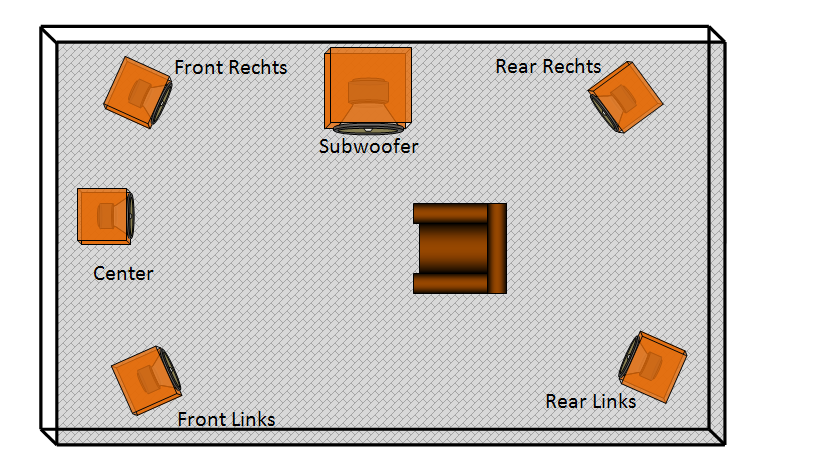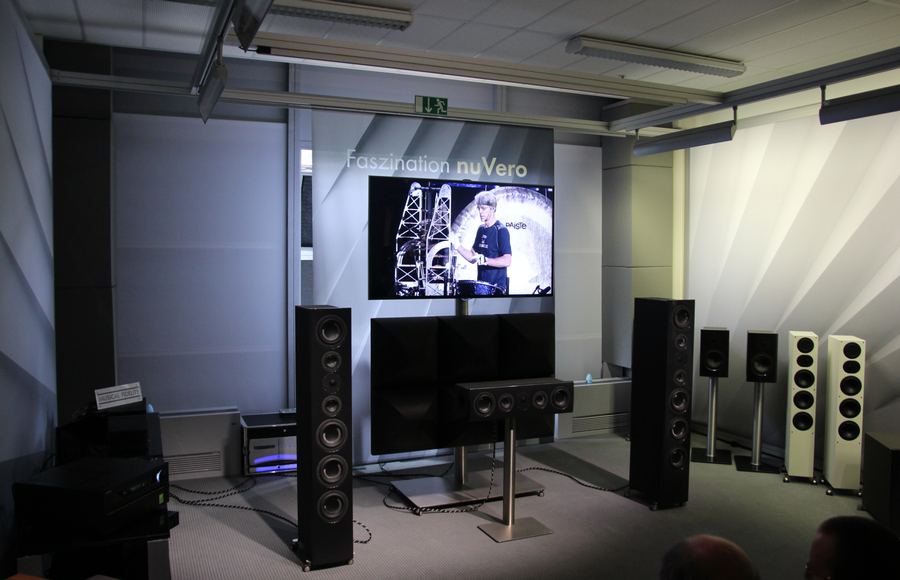1. Surround speakers - www.hifilounge.eu
Main menu:
- Home
- General
-
Speakers
- Basics
- Speakers
- Headphones
- Subwoofer
- Elektronics
- Surround
- Photography
- Infos
1. Surround speakers
Surround
Mono sound goes with a loudspeaker. Stereo needs two speakers. But there's more... With Dolby Atmos you can drive 34 speakers and an additional subwoofer. If you put more speakers in the room, the sound can come from more different directions.
The simplest surround system consists of four speakers (=quadrophony). As usual, two stereo speakers are placed in a stereo triangle in front of one, two more speakers are placed at the back.
An additional sound carrier with surround tracks is required. Here we can take...
- Music: SACD or DVD Audio + Player
- Movies: DVD, BluRay or streaming services like Netflix, Amazon Prime,...
- Games: PC, Playstation, XBOX,...
In addition, we need an electronic device that can decode the surround signals from the data carriers and drive the loudspeakers. With inexpensive surround systems the electronics are usually integrated in the bass speaker (= Subwoofer), with more expensive systems there is a separate electronic component known as an Audio Video Receiver (=AVR).

Figure 1: Location and designation of surround loudspeakers
Usual are 5.1 installations. For this purpose, five loudspeakers for the mid-high range are distributed around the listener, in addition a subwoofer is set up which produces the bass. In the ideal case basses are not locatable, therefore the subwoofer can be placed freely. In practice, however, installation-dependent drone effects caused by room modes quickly restrict the freedom of free placement. Alternatively, there are 4.0 systems which use four full-range speakers and do without the subwoofer, or 7.1 systems which use two additional fullrange speakers.
In principle, normal stereo speakers can be used to set up a surround system.
However, at least with the center speaker one usually has to make compromises. The center speaker is usually placed underneath the TV and primarily reproduces the voices of the speakers. However, it is usually impossible to place a floorstanding loudspeaker underneath a television set, which is why many manufacturers offer special centre speakers for the systems. Dipole speakers are also often used for the rear speakers to get the rearsound with a more spacious stage.
The following picture shows a surround system by Nubert with floorstanding loudspeakers as fronts and a center speaker. The rear models and the subwoofer are not in the picture.

Figure 2: Surround system with floorspeakers and centerspeaker from Nubert at a fair.
The setup shown was a so-called 7.1 surround setup. The sequence of numbers means: there are 7 normal loudspeakers for the midrange and high frequencies, plus an additional speaker (subwoofer) for the bass. Since a subwoofer can't be located due to the high wavelength of low frequency sounds, the bass response can be transferred to a separate speaker.
The following statements can be made about a surround setup:
- Front speakers: Since over 80 percent of the music comes from the front even in surround recordings, this is where you should focus if you have a limited budget. If you plan to listen to stereo CDs with the system, you will primarily depend on these speakers. Using full-fledged floorstanding loudspeakers for this purpose is basically not wrong. If you look at the percentage of sales mentioned above, you might understand why stereo systems so stubbornly refuse to disappear from the market.
- Center: The only speaker more important than the front speakers in surround sound. In movies, the actors often walk through the front of the picture, and the center should match the front speakers so that speech and music always sound the same.
- Rear: In movies, only effects sound usually comes from behind, so much cheaper models can be used at the rear. Special dipole loudspeakers sound particularly spacial and enhance the surround effect.
- Subwoofer: Subwoofers are usually active and usually have a so-called low bass equalisation. With this technology, even inexpensive subwoofers can produce significantly lower frequencies than most floor-standing speakers with a similar membrane surface. Ideally, all mid-high speakers in a surround system should be from the same series from the same manufacturer. With the subwoofer there is no reason for this restriction apart from a homogeneous appearance.
The unloved center
Most dialogues in movies come from the front, so the centre speaker is one of the most important speakers in the system. In practice, one should be careful when choosing a center.
Mostly center speakers are unlovingly tinkered misconstructions. The main development goal is often that the center somehow fits under the TV and visually matches the front speakers. Center speakers are often an absolute catastrophe in terms of sound, there are only few good models on the market.
Good stereo speakers have a very sharp center image. This raises the question why one should buy a centre speaker at all - which then takes over the middle between the speakers with mediocre success. The answer: In many private home theatres the speakers and seats are placed very unfavourably in the room. To ensure that the voices in movies come from close to the TV, it is imperative that a loudspeaker is placed near the TV.

If you can distribute the seats and speaker positions in a good way: The absence of a center is often advantageous in terms of sound!
Disadvantages of centre speakers:
- In stereo systems identical speakers are usually used. Due to the identical construction of the speakers, the phase respnse are also identical due to the identic crossovers/drivers, the ear can thus achieve a homogeneous location of the sound sources. The center is often build differently. And it has a different phase response if the crossover/chassis concept is different. This can lead to voices literally jumping when a speaking actor wanders through the picture from left to right.
- The construction of many centers is as follows: In the middle a tweeter, left and right two parallel connected bass-midrange drivers. This results in extreme drops in horizontal directivity. This results in a strange sound for seats lying to the side.
- The mid-high unit of most floorstanding speakers is at the same height as the middle of the television set. Accordingly, the actors' voices are at the expected height. Center speakers, on the other hand, are usually located below the television, resulting in the voices coming from below. Some listeners find this disturbing.
How to do centers right
- If possible: Use stereospakers with good staging. Dont use a center.
- If a center must be used: Take center speakers that match the front speakers. The only type of multi-way loudspeaker -where the mid/high section can be rotated without any problems with the technical side radiation- are those with coaxial drivers for the mid/high range. If the front speakers are equipped with coax drivers, it is indeed possible to build a useful cross-directional centre counterpart. Even here the voices of the actors do not come from the center of the picture but from the center.
- Some hi-fi enthusiasts use two center speakers, one above and one below the TV to ensure that the voices are correctly centered. But this is at the expense of strong vertical comb filter effects.
- The only uncompromising solution: Get a beamer and a perforated sound-transmitting cinema screen use the same type of speaker as for the front speakers as the centre speaker. Now the construction type and height of the center speaker is also correct.
Rearspeaker
Very popular are also dipole and bipolar speakers in the back of a home cinema.
Bipoles radiate in different directions with the same phase, this can be realized e.g. by an additional tweeter at the back of the speaker. Alternatively, there are also dipoles that radiate in phase inverse to the front and rear, e.g. large electrostatic area radiators. Both loudspeaker variants rely on a high proportion of reflected sound, which results in an increase in stage size at the expense of location accuracy. This is not a bad choice for movies, but those who prefer the authentic realisation of delicate piano music may be better off with direct radiators. Since many dipoles have a switch-over function to direct radiating, this should disturb in the least cases.
Subwoofer
I wrote a seperate chapter *click* since subwoofers are a relatively complex subject,